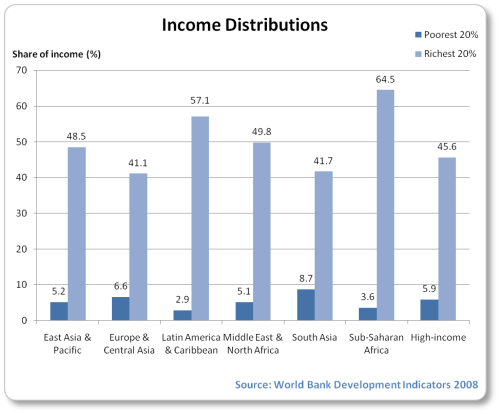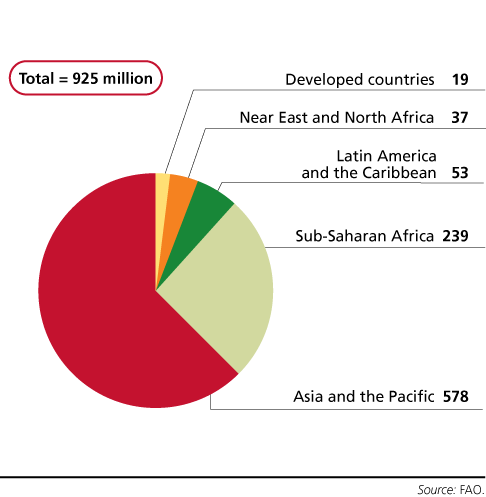According to the Food and Agriculture Organization (FAO) report of 2010, about one sixth of the world population lives in poverty. The report further clarified that of the poverty stricken people about 925 million suffer from chronic hunger. World Health Organization 2010 report estimated that 53% of infant and childhood death in developing countries are due to complications caused by malnutrition.
FAO on almost yearly basis suggests that the world has the potential and capability of fighting hunger if people have the will and commitment (World Health Organization). This paper looks into the main cause of hunger and suggests how the epidemic can be solved.
World hunger cannot be blamed on one particular parameter or factor however it’s the end result of a number of interrelated factors. Most of the factors lead to one another that the occurrence of one is likely to trigger the other; the most challenging factor is that the factors seem easy to handle but their effects have continued to challenge humanity for decades. The following are the main cause of world hunger (Maddocks, 22).
Poverty is one factor that can be blamed for hunger in the world; according to United Nations World Food Programme (WFP) poverty is the inability to achieve on a sustainable basis, the human basic necessities; poor people are not able to live basic common life.
Poor people are not able to provide himself with human basic needs like food, shelter, housing, basic education, and health among other human necessities like get clean and safe drinking water, sufficient nutrition, energy for cooking food and lightening, clothing and beddings, and their living conditions is wanting.
Poverty has its main causes, when it prevails in the society; the people are not able to provide themselves with sufficient food as may be required for their live hood. The chart below shows the poverty state of different countries:

(World Health Organization)
In the wave of new millennium, 2000, the United Nations Millennium Development Goals (MDGs) in 2000 had their first agenda as eradication of poverty and hunger all over the world by 2015. The Agenda is still ongoing but its success rate is not satisfactory; a report by WFP in 2010 suggested that although world poverty is reducing the numbers of people who are not able to feed themselves are wanting.
The words of the report were echoed by FAO Director General when he said “The silent hunger crisis — affecting one sixth of all of humanity — poses a serious risk for world peace and security” (Hunnicutt 23). The chart below shows the statistics of hunger in the world:

The majority of poverty stricken people who happens to be suffering from hunger live in Africa, the Pacific, Caribbean, and Asia (the continents form approximately 90%). When people are hungry they are not able to engage in economic development programs thus aggravating their poverty rates and future hunger situations (Maddocks 12-26)
Natural calamities can be blamed for world hungers; in the near past, the world has been facing an increasing number of natural calamities some that can be blamed on human beings and some that occur without the control of man.
When calamities face human kind they are not able to provide themselves with sufficient and nutritious foods as is required for a decent living. Natural calamities cannot be said to be dominant in any particular country however when they occur the response of national and international community to handle them determines whether there will be hunger or not.
According to World health Organization, developing countries largely depend on rainfall driven agriculture; however in Asia, Africa and Latin America which are among the most productive areas faces absolute poverty and hunger (the report suggests that about 500 million of the continents residents live in absolute poverty).
Changes in climatic conditions and trend has seen the world not being able to correctly predict the weather pattern to plan crops and rear animal that offer them food. When rainfall fails people are left without reliable source of food which thus they get hungry. It is estimated that every year about 15 million children die of hunger; WHO estimates that one third of the world is starving, one third is underfed and the other one third can feed itself sufficiently (United Nations).
As many other factors, human and their activities continues to be responsible for sustained hunger emergencies in the world; since 1992, it is estimated that about one third of the hunger stricken places are suffering from wars or ethnic conflicts. When people are fighting, they fail to engage in sustainable food production activities thus they lead to hunger.
During wars there is always massive destruction of property and some include food; this deteriorates the food situation in war torn countries. Studies have suggested that in world most poor countries, there are traces of war and ethnic conflicts, the study also creates a link and relationship between poverty and economic stagnation which in turn causes conflicts which aggravates poverty (Shaohua 12-45).
The photo below shows hungry children in war striken Somalia:

FAO has continued to suggest that the world hunger situation can be solved of the people have the will and commitment to do so; Martya Sen, the 1998 Nobel Prize Laureate in Economics states “The tendency to think of growing more food as the only way of solving a food problem is strong and tempting, and often it does have some rationale” (World Food Program Official Website).
Other than the suffering nations being reduced to handouts users, governments, nongovernmental, and the international community has the task of developing sustainable mechanisms through which the people can handle their future food needs. Some of the activities and strategies that should be implemented include sustainable agriculture where the level of reliance on rainfall is checked.
Although sub-Saharan countries have fertile soils and good climatic conditions for agriculture, they have continued to live in poverty as they lack sustainable farming practices. Irrigation and use of research to develop crops that can sustain long spells of drought can be a good solution.
Other than offering food solutions, governments should embark on programs that improves their countries economic standing; they should ensure education is accessible and affordable (World Food Program Official Website).
Conclusion
Despite the first United Nations Millennium Development Goals (MDGs) agenda of 2000 being eradication of poverty, approximately a sixth of the world population lives in poverty. Of the poor people approximately 925 million are at the risk of hunger; hunger is caused by a number of intertwined factors.
These factors include poverty, wars and community conflicts, and natural disasters. To eradicate hunger, international community, national governments, non-governmental bodies, community based programs, and individuals should combine efforts and seek solutions for particular problems in different nations. Focus should shift from programs that feed the hungry people to those programs that lead to sustained food production.
Works Cited
Hunnicutt, Susan. World Hunger. Pennsylvania: Greenhaven Press, 2006. Print.
Maddocks, Steven World Hunger. New Jersey: Gareth Stevens Publishing, 2004. Print.
Shaohua, Chen, and Martin Ravallion. How have the world’s poorest fared since the early 1980s. Washington: World Bank, 2004.
United Nations. United Nations Millennium Development Goals (MDGs) , 2011. Web.
World Food Program Official Website. World Food Program, 2011. Web.
World Health Organization. World Hunger, 2011. Web..